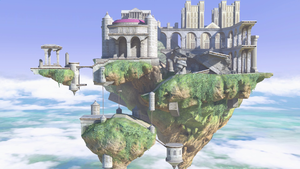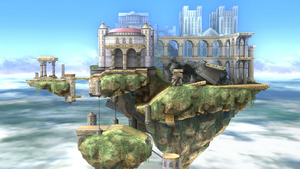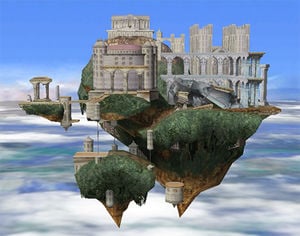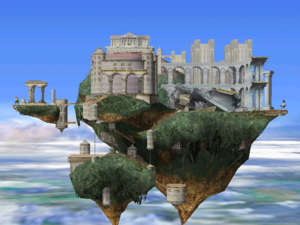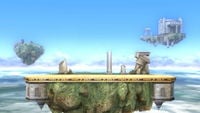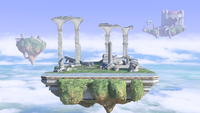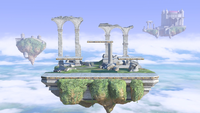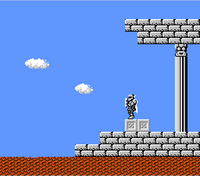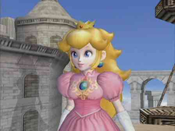Temple
| The Legend of Zelda Hyrule: Temple | |
|---|---|
 Temple, as it appears in the Smash series. | |
| Universe | The Legend of Zelda |
| Appears in | Melee Brawl SSB4 (Wii U) Ultimate |
| Availability | Starter |
| Crate type | Normal |
| Maximum players | 4 (Melee and Brawl) 8 (Wii U and Ultimate) |
| Article on Zelda Wiki | Dungeons in The Adventure of Link |
Temple (神殿, Temple) is a stage introduced in Super Smash Bros. Melee, which returns in Super Smash Bros. Brawl as a Melee Stage, and in Super Smash Bros. for Wii U and Super Smash Bros. Ultimate as a familiar stage. It is commonly known as Hyrule Temple (this name appears in Melee's instruction booklet at page 49), though its proper name is Temple (since "Hyrule" denotes Temple's location). Temple was first announced at E3 2001. In Melee, Roy is fought here for his unlocking battle, while in Ultimate, Zelda is fought here for her unlocking battle.
Stage overview[edit]
Temple is one of the eighteen default stages available in Super Smash Bros. Melee. It is a Legend of Zelda stage on which characters from that franchise (along with the characters from the Fire Emblem franchise) will usually battle the player in the single player modes. The layout is based on the palaces from Zelda II: The Adventure of Link.
In Melee's All-Star mode, this stage is played on when Zelda and her teammates are fought. It is also where Zelda will fight in Classic Mode and will sometimes play the song "Lost Woods", from The Legend of Zelda: Ocarina of Time.
In Super Smash Bros. Brawl, the stage no longer has a chance of playing the "Fire Emblem" medley theme from Melee, because the track has moved to the Fire Emblem-themed Castle Siege stage. A remix of the "The Great Temple" theme from Zelda II: The Adventure of Link can be obtained to play on this stage in My Music, making it the only Melee stage that has a new piece of music available to play on it. In Brawl, the ledge on the right hand side can no longer be grabbed on the larger bottom platform as it could in Melee.
Fight Club[edit]
See also: Cave of life
The underground area on the stage is referred to by Nintendo Power as the "Fight Club". It is termed so because battles there tend to produce disproportionately high damage totals because the surrounding environment has walls on all sides that can be teched on, which keeps characters from leaving the stage and greatly increasing the difficulty of KOing them. The ease in which a high damaged character can survive in the Fight Club can often lead to players turtling inside. The area is also known by a variety of other nicknames by players, such as "The Pit".
Hyrule Jump[edit]
Due to its immense size and its structure, Temple is a stage where notable feats involving the traversing of large area are performable, such as the Hyrule Jump and, as of Brawl, gliding completely around the stage.
Ω forms and Battlefield form[edit]
In Super Smash Bros. for Wii U, the Ω form is set on a much smaller stage retaining some of the designs from the original stage. The original stage can be seen in the background, split up.
In Super Smash Bros. Ultimate, the Ω form and Battlefield form are set on a platform similar to the stage's Ω form in SSB4, but it is resized and reshaped to match Final Destination and Battlefield, respectively. The three soft platforms of the Battlefield form resemble the soft platforms of the regular form.
Origin[edit]
This stage is loosely based on the palaces of Zelda II: The Adventure of Link. However, there are a few clear references: the top left portion resembles the entrances to the palaces, while the building on top of the mountain in the background resembles the sprite used to represent palaces in The Adventure of Link's overworld. The palaces in The Adventure of Link are subterranean and somewhat labyrinthian, which is reflected in the stage’s layout.
The platforms on this stage have Hylian writing on them. In Melee, the writing appears to resemble the Hylian language in The Legend of Zelda: Ocarina of Time; however, it is not actually based on the language. In Smash 4 onwards, it is based on the Hylian language from The Legend of Zelda: The Wind Waker. When decoded, the text reads スマッシユ・ブラザーズ, which translates to "Smash Brothers".
Tournament legality[edit]
As an extremely large stage, it is banned in all serious tournaments in every game it is featured in because its size and build provides opportunities for what is perceived broken camping and stalling. The many walls allow for wall infinites, and the underground section creates a large cave of life, allowing characters to live to extremely high damages that are effectively impossible to reach in normal conditions. The geometry of the stage also allows players to circle camp endlessly with characters such as Meta Knight or Jigglypuff, encouraging extremely slow hit-and-run matches, as well as favoring stalling. As a result of having areas where the upper blast line is much closer to the stage than the horizontal blast lines, this stage also gives characters with powerful vertical finishers a benefit over those with powerful horizontal finishers.
Temple Race[edit]
Temple Race is a gameplay variant described in Melee's instruction booklet. It suggests that players define a route through the complex stage, begin a timed match, and race to see who can complete the most laps before the timer expires. As computer players will only fight, this is a players-only variant.
Description in the Instruction Booklet[edit]
Play a MELEE battle in Time Mode. Set the time and choose the HYRULE TEMPLE stage. Choose a particular route, then see who can complete the most laps within the time limit.
Gallery[edit]
Super Smash Bros. Melee[edit]
Super Smash Bros. Brawl[edit]
Bowser, Wario, and Diddy Kong in Temple as it appears in Super Smash Bros. Brawl.
Super Smash Bros. for Wii U[edit]
Temple in Super Smash Bros. for Wii U.
Toon Link and Link on Temple as it appears in Super Smash Bros. for Wii U.
Super Smash Bros. Ultimate[edit]
Kapp'n taking Donkey Kong away from a taunting Zelda.
Link about to perform his forward smash.
Rosalina & Luma striking Kirby with her up smash.
Mr. Game & Watch using Chef on this stage.
Mythra on the stage.
Names in other languages[edit]
Videos[edit]
Trivia[edit]
- In Melee, if Sheik's Chain is used in the correct spot in the tunnel of Temple, the tip of the chain will stick to the roof of the tunnel and make a straight line from her hand to the roof. This is sometimes referred to as the Sticky Chain glitch. In Brawl, there is another glitch involving Sheik's Chain when used in the right position on the stone slab to the right of the entrance to the underground area. If performed correctly, the chain makes a high pitched sound that is different from the usual sound produced.
- In Melee, Temple is notorious for exploiting the flawed AI. One such example is if Jigglypuff and Kirby are knocked off the left side of the lower part of the stage, they will attempt to return using their multiple midair jumps, but will sometimes get stuck on the slight overhang above. This is usually not fatal to Jigglypuff, as it will often glide back to the platform after its jumps are exhausted, but Kirby will use his Final Cutter and fall straight down for a SD. Another notable example is where Fox as a level 9 CPU cannot escape from the lower area of the stage if the player is on the top area, as it will attempt to jump on the path leading to the top but fail, walk side to side on the bottom, fall off the right side, use Fire Fox to get back up, and repeat. With the improved AI, these specific CPU exploits do not occur in Brawl.
- In the "Special Video" of Melee, during two clips of Temple, two odd platforms can be seen, which do not appear on the stage in Melee, Brawl, Smash 4 or Ultimate. The same platforms can be seen in the short video clip after beating a single player mode as Luigi as well as in the manual's picture depicting Fixed-Camera Mode.
- Along with the platforms, early versions of the game featured an elevator to lead to the bottom of the stage, similar to those found in the palaces of The Adventure of Link. However, this does not appear in the finished form of the game.
- If Pokémon Trainer is chosen, he stands on top of the arches in the middle section of the stage.
- If Sonic releases his Spin Dash while facing right on the stairs to the left of the large floating platform, he will shoot horizontally across the stage, going over any gaps, ignoring gravity, and self destruct.
- In the PAL Spanish version of Smash 4, the name of this stage was originally that of Summit's, before being corrected in a patch.
- This is one of the two familiar stages in SSB4 to not appear in Classic Mode or All-Star Mode, the other is 75m.
- In Super Smash Bros. for Wii U, unused text suggests Temple was originally going to be an unlockable stage. This would have been the only time in the series the stage would have been unlockable.
- Prior to Ultimate, this was the only familiar stage to receive a major graphical overhaul in a later title, that being Super Smash Bros. for Wii U.
- This is so far the only stage in the series to be used in the box art of a Super Smash Bros. game.
- In Ultimate, the following Assist Trophies can only appear on the Battlefield and Omega forms of this stage: the Moon, Andross, Tiki, Devil and Rathalos. Additionally, the following Poké Ball Pokémon can only be summoned on the stage's Battlefield and Omega forms: Alolan Exeggutor, Lugia, Lunala and Marshadow.
- Temple is the first non-original multiplayer stage to not feature either conventional hazards or moving platforms.
| Stages in Super Smash Bros. Melee | |
|---|---|
| Starter stages | Brinstar · Corneria · Fountain of Dreams · Great Bay · Green Greens · Icicle Mountain · Jungle Japes · Kongo Jungle · Mushroom Kingdom · Mute City · Onett · Pokémon Stadium · Princess Peach's Castle · Rainbow Cruise · Temple · Venom · Yoshi's Island · Yoshi's Story |
| Unlockable stages | Battlefield · Big Blue · Brinstar Depths · Final Destination · Flat Zone · Fourside · Mushroom Kingdom II · Poké Floats |
| Dream Land · Kongo Jungle · Yoshi's Island | |
